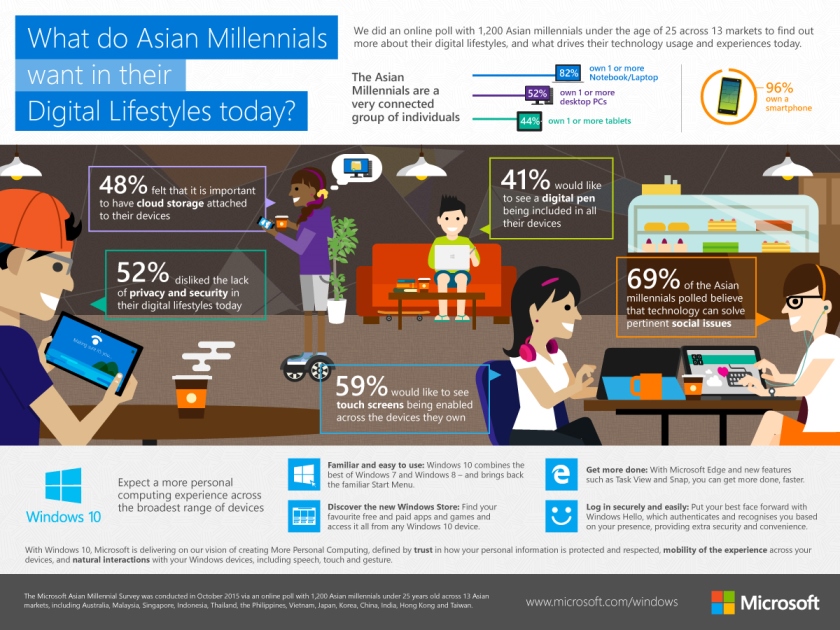During this festive season, 1 in 3 Asian youth would like to get a smartphone for the; and 2 in 5 would like to consider a tablet, laptop or 2-in-1 device
Asia Pacific – December 2016 – Asian youths today are showing strong awareness of cyber-risks while devices and digital services are front and centre of their lives – this is one of the key findings unveiled by Microsoft today a poll to find out about the digital habits of millennials in a mobile-first and cloud-first world.
The online poll was conducted in September 2015 with 1,200 Asian millennials under 25 years old across 13 Asian markets, include Australia, Malaysia, Singapore, Indonesia, Thailand, the Philippines, Vietnam, Japan, Korea, China, India, Hong Kong and Taiwan.
There are 1.1 billion youths in Asia, which makes up about 60% of the world’s youth population[1], Inevitably, youths are driving the agenda how future Asian workforce are centring their work and live in an increasingly digital world.
The poll showed the pervasiveness of devices in the lives of Asia millennials, where all respondents own a smartphone. Notebooks or laptops are their choice for a full-productivity device followed by desktop PC and tablet. Almost 40% of all respondents own a gaming console. Wearable devices are still at a nascent stage of adoption where only about 17% of respondent own one.
The poll shows that these Asian millennials are already making their own purchase decisions with all their devices. Approximately one third of the respondents desire to purchase smartphones followed by 19.3% and 13.3% wishing to get laptop and tablet relatively.
Here are the six key findings about what Asian millennials expect of their devices and services:
- Youths want mobility: The poll showed the pervasiveness of devices in Asia millennials, where all respondents own a smartphone. Notebooks or laptops are their choice for a full-productivity device followed by desktop PC and tablet. Almost 40% of all respondents own a gaming console. However, wearable devices are still at a nascent stage of adoption where only about 17% of respondent own one;
- Youths want natural gestures with their technology: From smartphones to their notebooks, they want stylus and touch experiences embedded in their devices within 6 months’ time;
- Youths want convenience of the cloud: Respondents want to store their files in the cloud for easy access across devices and locations;
- Youths want a safer digital environment: Majority of respondents dislike the lack of privacy and security in their digital lives – in fact, 70% are willing to pay to overcome their current privacy and security challenges. It is not surprising that of the biggest technology advances that they would like to see in three years’ time is integration of biometric features in their devices, such as iris scan;
- Youth wants simplicity in an increasingly complex technology environment: 610 of respondents felt that one of the biggest challenges in their digital lives is having too many passwords to remember; and
- Youths want to build a brighter future with technology: The poll showed that 70% of youths believe that technology can solve social issues such as equality, diseases and environmental issues we are facing today.
The poll showed that by 2020, Asian youths would like to see their devices able to have holographic displays, virtual personal assistants, brain-computer interface, gesture controls and ability for software to conquer language barriers.
Windows 10 – Ushering an era of ‘More Personal Computing’
Inspired by digital lives in a mobile-first and cloud-first world, Microsoft has mapped a bold new ambition to create an era of ‘More Personal Computing’, where technology is personal, simple yet powerful enough to maximize our potential.
With Windows 10, launched since July 2015, Microsoft has introduced a device platform that delights people at work, at play, and beyond – by radically simplifying the way we interact with it. The new Windows empowers people to do great things, delivering innovations like Cortana, Windows Hello, Microsoft Edge, Continuum, the Xbox app and so much more to your PC, tablet, or phones.
Guenter Weimer, General Manager of Windows, Microsoft, said: “With more than 110 million devices are already running Windows 10, including 12 million business PCs – a faster adoption rate than Windows 7 or Windows 8 – the new Windows has captured the imagination of consumers and businesses alike. We are excited for more consumers to be discovering a new era of ‘More Personal Computing’ with the widest Windows devices line-up ever during this holiday season in Asia.”

